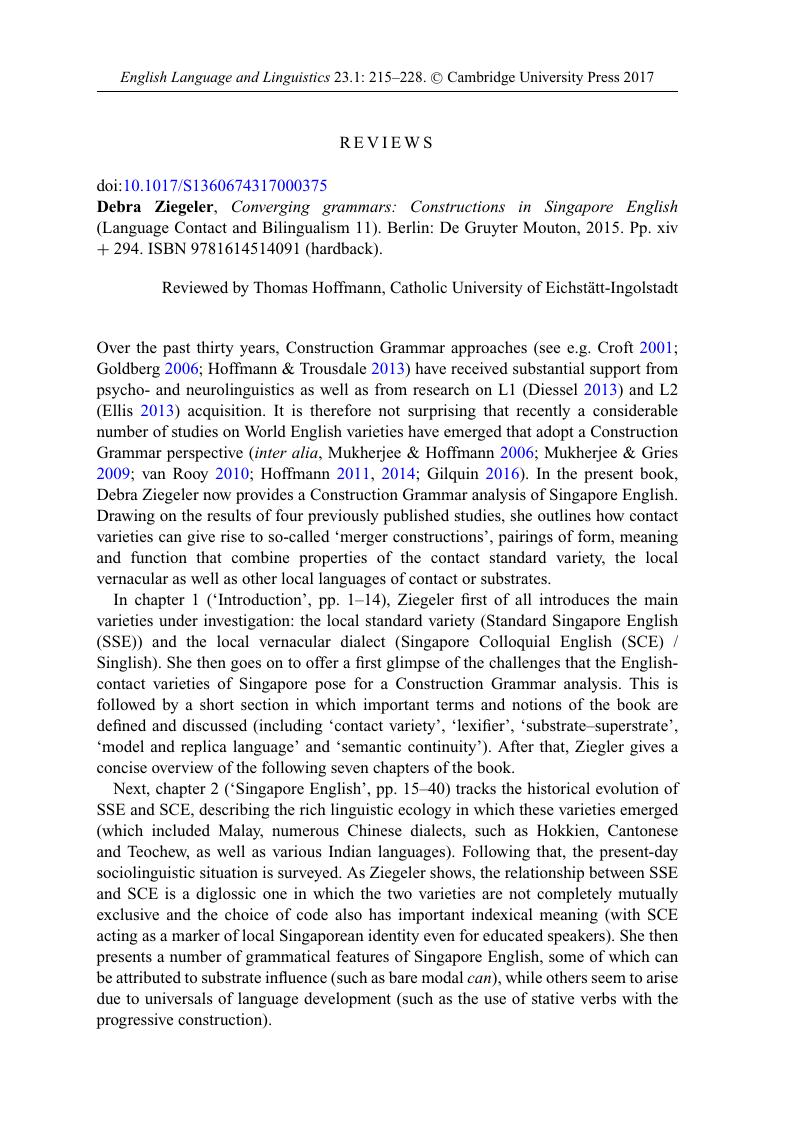No CrossRef data available.
Article contents
Debra Ziegeler, Converging grammars: Constructions in Singapore English (Language Contact and Bilingualism 11). Berlin: De Gruyter Mouton, 2015. Pp. xiv + 294. ISBN 9781614514091 (hardback).
Published online by Cambridge University Press: 08 August 2017
Abstract
An abstract is not available for this content so a preview has been provided. Please use the Get access link above for information on how to access this content.

- Type
- Book Review
- Information
- Copyright
- Copyright © Cambridge University Press 2017
References
Barðdal, Jóhanna. 2008. Productivity: Evidence from case and argument structure in Icelandic (Constructional Approaches to Language 8). Amsterdam: John Benjamins.Google Scholar
Bybee, Joan. 2013. Usage-based theory and exemplar representations of constructions. In Hoffmann, Thomas & Trousdale, Graeme (eds.), The Oxford handbook of construction grammar, 49–69. Oxford: Oxford University Press.Google Scholar
Croft, William. 2001. Radical Construction Grammar: Syntactic theory in typological perspective. Oxford: Oxford University Press.Google Scholar
Croft, William & Alan Cruse, D.. 2004. Cognitive linguistics. Cambridge: Cambridge University Press.Google Scholar
Diessel, Holger. 2013. Construction Grammar and first language acquisition. In Hoffmann, Thomas & Trousdale, Graeme (eds.), The Oxford handbook of construction grammar, 347–64. Oxford: Oxford University Press.Google Scholar
Ellis, Nick. 2013. Construction Grammar and second language acquisition. In Hoffmann, Thomas & Trousdale, Graeme (eds.), The Oxford handbook of construction grammar, 365–78. Oxford: Oxford University Press.Google Scholar
Fauconnier, Gilles & Turner, Mark. 2002. The way we think: Conceptual Blending and the mind's hidden complexities. New York: Basic Books.Google Scholar
Gilquin, Gaëtanelle. 2016. Input-dependent L2 acquisition: Causative constructions in English as a foreign and second language. In De Knop, Sabine & Gilquin, Gaëtanelle (eds.), Applied Construction Grammar, 115–48. Berlin: De Gruyter Mouton.Google Scholar
Goldberg, Adele E. 2006. Constructions at work: The nature of generalisation in language. Oxford: Oxford University Press.Google Scholar
Höder, Steffen. 2014. Constructing diasystems: Grammatical organisation in bilingual groups. In Åfarli, Tor A. & Mæhlum, Brit (eds.), The sociolinguistics of grammar (Studies in Language companion series 154), 137–52. Amsterdam: John Benjamins.Google Scholar
Hoffmann, Thomas. 2011. Preposition placement in English: A usage-based approach. (Studies in English Language). Cambridge: Cambridge University Press.Google Scholar
Hoffmann, Thomas. 2014. The cognitive evolution of Englishes: The role of constructions in the Dynamic Model. In Buschfeld, Sarah, Hoffmann, Thomas, Huber, Magnus & Kautzsch, Alexander (eds.), The evolution of Englishes: The Dynamic Model and beyond (Varieties of English Around the World G49), 160–80. Amsterdam: John Benjamins.Google Scholar
Hoffmann, Thomas & Trousdale, Graeme. 2013. Construction Grammar: Introduction. In Hoffmann, Thomas & Trousdale, Graeme (eds.), The Oxford handbook of construction grammar, 1–12. Oxford: Oxford University Press.Google Scholar
Mukherjee, Joybrato & Gries, Stefan. 2009. Collostructional nativisation in New Englishes: Verb-construction associations in the International Corpus of English. English World-Wide 30, 27–51.Google Scholar
Mukherjee, Joybrato & Hoffmann, Sebastian. 2006. Describing verb-complementational profiles of new Englishes: A pilot study of Indian English. English World-Wide 27, 147–73.Google Scholar
Pietsch, Lukas. 2010. What has changed in Hiberno-English: Constructions and their role in contact-induced change. Language Typology and Universals 63, 118–45.Google Scholar
Ungerer, Friedrich & Schmid, Hans-Jörg. 2006. An introduction to cognitive linguistics, 2nd edn. London and New York: Pearson Education.Google Scholar
Van Rooy, Bertus. 2010. Social and linguistic perspectives on variability in World Englishes. World Englishes 29 (1), 3–20.Google Scholar




